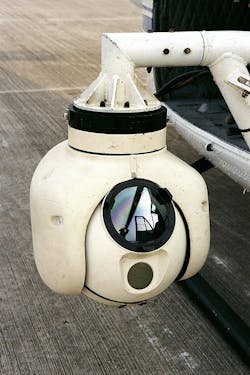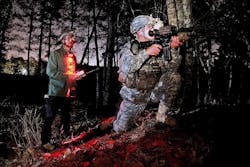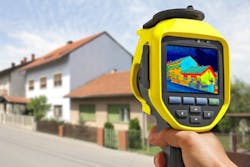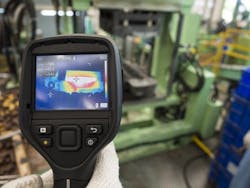Use of thermal imaging cameras pervasive across aerospace, engineering, and other industries
By John Paul
An elite Special Forces team patiently awaits orders to storm a building where terrorists are currently located. It is way past sunset and the power inside the building has been turned off to their disadvantage. There’s no way to locate the enemy without putting brave soldiers in danger. That was the case until thermal imaging cameras entered the battlefield.
A Paratrooper Using a Thermal Imaging Scope, Flickr - The U.S. Army, CC 2.0
Thermal imaging technology has been made all too familiar and glorified, often with artistic liberty, in a slew of action movies ranging from Predator and Terminator 2 to The Expendables and Oblivion. So it’s not too surprising that those not caught up in the latest thermal imaging cameras only see the immediate use in military and law enforcement operations. Who else would use this technology? We can almost hear a bunch of engineers laughing out loud in response.
Thermal imaging cameras have not-so-glamorous and critical roles in a wide range of industries. They have a life beyond military operations and definitely beyond T-800s and Mission Impossible movies. And they are very different from night-vision goggles.
Night-vision goggles work as image intensifiers. They need tiny amounts of light present in near darkness to enhance the surroundings for the user’s eyes. But if you're a soldier trying to locate enemies in a dark building, an image intensifier would be of no use.
How does a thermal imaging camera work?
Thermal imaging has come a long way since the U.S. military and Texas Instruments developed the first infrared line scanner back in 1947 – it took one hour to develop a single image. Thermal imagers today have transformed the field of video surveillance in airports, security, and manufacturing plants.
Thermal imaging, instead of looking for the light that objects reflect, uses the heat they radiate. Living things, vehicles, and machines are usually hotter than their surroundings and give off infrared radiation, which is a similar kind of energy to light but with a slightly longer wavelength.
A thermal imaging camera picks up infrared radiation from hot objects and converts it into visible light. It works like a digital camera except the image detector chip uses infrared radiation instead of visible light. The image produced is called a thermogram, which displays temperature differences across bodies and surfaces. Thermal imagers can detect relatively warm targets, such as vehicles and people, through fog, haze, smoke, and in total darkness. They are more than just surveillance tools, however. Take a look at their pervasive, yet lesser-known applications:
Applications galore:
1. Industrial
Thermal imagers allow engineers and inspectors to see things they never observed before. They can perform a non-destructive examination and non-invasive monitoring of machines and operations. This underscores the ability of thermal imaging cameras to detect potential problems before they happen and cause major damage.Thermal imaging has proven to be of immense value in bearings, electrical systems, and a host of other applications.
2. Agriculture
In states like Minnesota, farmers usually pile harvested sugar beets in large pyramids, and process one pile at a time. However, if one beet begins to decay and ferment inside a large pile, it can contaminate, and could ultimately destroy, most of the pile before detection. Thermal imaging cameras can reveal which piles are heating up the fastest and identify which needs to be processed first. Thermal imaging can prevent crop damage in time and, needless to say, result in massive cost savings.
3. Construction
Thermal imaging comes in handy throughout the field of construction. These cameras can detect heat loss due to poor window or wall performance before repairs.
View of a building using a thermal imaging camera
Thermal imaging also helps to find leaks in insulation and can determine the air quality of the building. For instance, in houses near highways, these cameras can "see" exhaust gases from vehicles, and can help reveal locations where they are leaking into the structure.
4. Medical Investigations
Infrared thermal imaging has a significant niche in the healthcare field today. Due to the correlation between body temperature and diseases, infrared thermography (IRT) can diagnose peripheral vascular disorders. Thermal imaging cameras can show temperature gradients in affected regions of patients with vascular disorders, indicating abnormal blood flow.
For patients who cannot undergo an MRI, thermal imaging is a low-cost initial step, especially when symptoms are not specific and could have multiple features. The University of Southern California forayed into revolutionary brain surgery by using thermal imaging to discover the margins of primary and metastatic brain tumors. It’s crucial to have imagers designed for with clinical and medical applications, with the right image postprocessing software.
5. Firefighting
Instruments like MODIS (which stands for Moderate Resolution Imaging Spectroradiometer) onboard Aqua and Terra satellites already use infrared data to see through smoke and pinpoint origins of massive forest fires. In such cases, infrared data is critical in distinguishing flames from smoldering burn scars and for other purposes.
Helicopter-mounted infrared camera helps fight brush fires
Firefighters are expected to help from above with the days of thermal imaging drones on the horizon. From agricultural fires to urban firefighting, it is expected that drones fitted with thermal imaging cameras can pinpoint victims or provide vital information to teams fighting the flames. Firefighters already use handheld cameras and masks fitted with thermal imaging cameras. They could soon have drones equipped with thermal imagers that can aid emergency response teams in dangerous scenarios.
6. Aerospace
In an industry with stringent design and safety standards, aerospace requires thermal imaging camera systems to have resolutions of 20 mk, the frame rate of 100 Hz, and more. This is needed for accurate analyses of the thermal behavior of aero engines. Thermal imagers are instrumental in the quality control of fuselages, wings, and blades with fault analyses performed using thermal imaging cameras.
They also find use in active heat flow thermography for testing composite materials used in aerospace construction.
7. Food Processing
Few things are as critical in the food industry as the temperatures of perishable goods across various stages like production, transportation, storage, and sales. Illnesses due to contaminated foods validate the need for tighter process control. Thermal imaging systems are used in applications like checking package sealing, and locating undercooked products to checking ovens for the right temperatures, and observing freezer compartments.
8. Road Repair
Road inspectors are on the lookout for non-destructive testing methods to make their job easier, less costly, and more effective. Thermal imaging cameras have been used to create road diagnostics systems to perform damage analyses on bridges, highways, and other important locations to detect problems like moisture ingress, thawed ice underlying portions of roads and cracks that can be potentially dangerous.
9. Engineering
With thermal imaging cameras, researchers study prototypes, and machine parts to detect possible flaws in designs which causes excessive heat generated by electric current or by friction. Engineers can learn from defects to improve their designs and create longer-lasting parts.
A thermal imager to find actual machine temperatures
For instance, two identical motors running under the same load should look alike in a thermal imaging camera. If the thermographs don’t match, motor failure could be just around the corner. Quick detection of a failing component leads to proactive repairs and prevents costly downtime. In other cases, engineers can survey drill bits in a machine tool, and check for heat build ups saving working time, quality, and avoiding dangerous situations.
10. Environment Analysis
Digital thermal imaging cameras can also analyze subsurface oxidation in landfills by checking surface temperatures of the soil. They can detect levels of above ground petroleum, and hazardous waste tanks, measure product levels in drums, and containers, detect gas emanating from gas recovery wells, and are used to display temperatures of piping and equipment in landfills and industrial locations. In a world where environmental standards are non-negotiable and sustainability has become a priority for major industries, thermal imaging cameras are a worthy investment.
It might be useful to know that thermal imagers need not be always purchased. While thermal imagers for processes will need to be purchased and installed, a lot of applications require thermal imaging cameras for a short period of time. Thermal imaging camera rentals offer industrial-grade equipment from renowned manufacturers (the Fluke TI32 thermal imager being a popular one). You could look into renting or buying used infrared cameras for saleto offset capital purchases while still getting all the advantages of precise and reliable thermal imaging.
About the author
John Paul is the Community Outreach Manager at TRS RenTelco, one of the largest suppliers of electronic test equipment for rent, lease, and purchase in North America.
About the Company
TRS RenTelco provides new or used electronic test equipment for rent, lease, or purchase. Solutions are provided for the various type of equipment such as spectrum analyzers, network analyzers, oscilloscopes, etc., from leading manufacturers.
Search the Aerospace & Defense Buyer's Guide
You might also like:
Subscribe today to receive all the latest aerospace technology and engineering news, delivered directly to your e-mail inbox twice a week (Tuesdays and Thursdays). Sign upfor your free subscription to the Intelligent Inbox e-newsletter at http://www.intelligent-aerospace.com/subscribe.html.
Connect with Intelligent Aerospace on social media: Twitter (@IntelligentAero), LinkedIn,Google+, and Instagram.
Intelligent Aerospace
Global Aerospace Technology NetworkIntelligent Aerospace, the global aerospace technology network, reports on the latest tools, technologies, and trends of vital importance to aerospace professionals involved in air traffic control, airport operations, satellites and space, and commercial and military avionics on fixed-wing, rotor-wing, and unmanned aircraft throughout the world.





